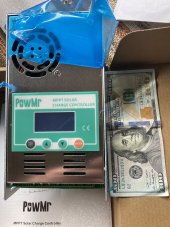The issue I had with fla was the 4210AN would constantly cut out and reset when equalizing. That is an issue.
With the current LiFePo’s there’s no equalize but once “full” voltage is achieved (which isn’t necessarily fully charged) it drops the amps to nothing and doesn’t work properly again unless I cycle off the panels or it goes overnight.
With fla you set HVD really high and do equalize too low with a lowered bulk setting and function fine is what I concluded. It was apparent bar 600W and troublesome when I went 800W.
Hmmm. In my project (solar panels, SCC, cables, etc all boxed up for deployment if needed, FLA batteries kept healthy on grid power), the equalization "glitch" of the 4210AN wouldn't be much of a headache. I'll be equalizing the batteries using grid power and a smart charger, if I ever need to equalize them using solar (unlikely), I can use your work-around method.
........ it drops the amps to nothing and doesn’t work properly again unless I cycle off the panels or it goes overnight.
This has been documented and lightly discussed. There is a video link in the thread below and in the comments someone mentions using a diode in the output to fix the issue. I have not confirmed this.
I have been running 5 strings of panels with 5 EPEVER Tracer BN 40a controllers. I noticed sometimes a string or two will stick at a low voltage and low current even though its in full sun. If I cover the panels, disconnect them and then reconnect it will track back to where it is expected...

diysolarforum.com
This glitch might be more of a problem. It's crazy that a person might have to keep watch on the thing and disconnect/reconnect the panels to get the controller to re-appraise the situation. I guess I could roll the dice and buy the 4210AN--Only 1 of sunsurfer's 5 controllers misbehaved, I might get a good one. Or, if this is caused by having panels in series and higher voltages, in my case my panels won't be far from the controller, so running all 4 in parallel wouldn't be a "costly cable" problem (so, maybe 21 Voc and 20A from the PV measured at the controller). Or, if (as sunsurfer has hypothesized) this only happens when multiple controllers are run in parallel, then I might not be susceptible to this problem at all if running just one controller.
The Epevers are popular, it would seem if this "gets stuck at low amperage and never recalculates" issue was
common that there would be a lot of fuss about it. It's good to know it happens, though, so if I buy a 4210AN (or 3210AN) I'll know what to look for. If I buy a less popular controller (PowMR, etc), it would still be a roll of the dice, and the "glitches" are less likely to be as widely documented.
Thanks again, I'll keep watching and learning from you guys.
Mark





